by Amanda Rohrer
September 2014
When the Legislature recently passed an increase to the state minimum wage, the question of whom it will affect arose. Does a higher minimum wage pad the wallets of spendthrift teens or put more nutritious foods on the tables in single-parent homes? Does it keep retirees afloat or discourage workers from putting in as many hours? Low-income workers are a diverse group. In some cases adults hold multiple jobs to make ends meet. Minnesota has the fourth-highest rate of multiple job-holding of any state.1 They may struggle against an employer who schedules fewer hours than they need to pay their bills. They may also be teens or college students working for discretionary income. Individual and family circumstances vary so much that, naturally, all of these scenarios play out. Better understanding who works for low wages helps to make policy and inform the debate, so this article delves into the available data on wages and workers.
Untangling income and poverty is complex, and existing measures often leave more questions than answers. The viability of an economic situation can be highly subjective; to a teenager working a few nights a week, even minimum wage may seem like wealth, while a parent weighing the merits of work against the cost of childcare would come to a very different conclusion. It's difficult to get at the motivations of workers from data because there is inadequate detail - incomes are reported in ranges or as above or below a given threshold, or too few personal and demographic details are tied to the income data. Each data source has its own strengths and weaknesses.
One common measure used is poverty status as defined by the Federal Government. It defines minimum income by family size for the 48 contiguous states and separately for Alaska and Hawaii. In the American Community Survey (ACS) many measures are reported by poverty status or some percentage (150%, 200%) of poverty status without any more detailed income data. The trouble with these statistics is 1) that cost of living varies by region and the federal poverty line does not; 2) poverty lines are unrealistically low; and 3) they do not take into account the source of income. Retirees or people receiving disability payments are not distinguished from those working minimum wage jobs.
The American Community Survey has some measures that are based on individual income. These are reported in broad income ranges and are fairly limited in terms of topics that they address. Despite their general nature these measures can be useful for understanding earnings and work habits.
By far the most comprehensive data set relating income and work is the Current Population Survey (CPS). This is the nationwide survey that is used to calculate the unemployment rate. Its main limitation is that, at the state level, it has a relatively small sample size so the reliability of statistics applying to a subset of the population can be called into question. For this article, this is the data source that was used most heavily. To address sample size concerns, data for the four most recent available years (2010, 2011, 2012, and 2013) were combined. While this approach doesn't allow for time series comparison, it gives us the clearest insight into what it means to be a low-income worker in Minnesota today.
In Minnesota 11.4 percent of all people are living below the federal poverty level. 17.1 percent of children under 5 years are living in poverty, and 29 percent of families with a single female head of household are in poverty. Nearly half, 48.2 percent of households, pay more than 30% of their income for rent. Females are somewhat more likely to be living in poverty, and children or families with children are much more likely to be living in poverty than the population as a whole. Having less than a high school degree or being a minority increases the likelihood of living in poverty.2
The federal poverty line is only $11,670 for an individual and $23,850 for a family of four3 - well below full-time work at minimum wage. A person working 40 hours a week, 52 weeks a year would earn $15,080 at the current federal minimum wage of $7.25 an hour. Because the federal threshold is so low, poverty status was not just a matter of low wages. Only 8.0 percent of people 16 and over living in poverty worked full time and year round but 42.8 percent worked part time or part year and 49.3 percent did not work. Barriers to work- the inability to find work, the unaffordability of childcare, and disability - may be greater contributors to poverty status than wages.4
To better understand the working poor - people who work full time and struggle against the wages they command - it's more useful to look at a higher annual income. The data that was available was limited, but this article looks mostly at workers earning wages of up to $20,000 annually (Map 1).
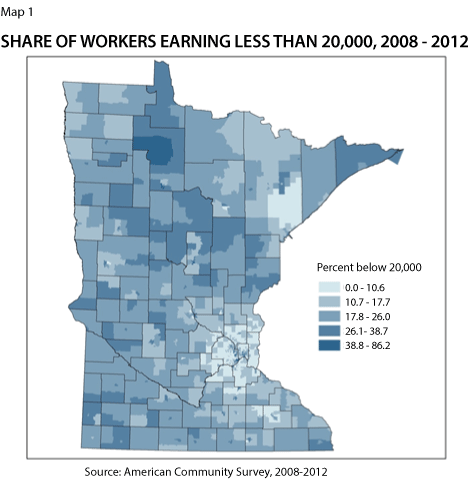
Although poverty is often cast as an urban problem, low wages are more prevalent outside of cities. Two thirds of low-income workers live in Metropolitan Statistical Areas (MSAs), the federal designation of major metro areas, and 27.7 percent of low-wage workers in Minnesota live in Hennepin and Ramsey counties alone. Even so, the percentage of all working individuals in rural areas who have low-incomes is higher than in all but a few urban Census Tracts. Overall, 13.1 percent of working metro adults earned less than $20,000, compared to 21.3 percent in metropolitans and 23.1 percent in rural counties.5 In the map below the share of full-time year-round workers 16 and older with earnings below $20,000 is displayed. For reference, if someone earning $9.50/hour worked 40 hours a week, 52 weeks a year, they would be earning just under $20,000.
While the ACS has more geographic detail on wage earners, it has very little demographic or social data associated with wage income. To delve more deeply into the characteristics of low-wage earners, we have to switch data sources and use data from the Current Population Survey. From that source, 54.0 percent of low-income workers are women, compared to 47.8 percent of all wage earners. 47.3 percent have never been married, compared to 30.7 percent of all wage earners. This is probably related to the ages of low-income workers (Figure 1). People 24 and under are disproportionately represented in the pool of low-income workers relative to their share of the total workforce. Because older workers have had more time to obtain skills and experience, they likely can command higher wages in most fields. Much older workers - people 65 and older - are also more likely to be low-income workers. However, since we're looking only at wage income, they're also more likely to have retirement or social security income. Despite the disproportionate share of younger people in the pool of lower-income workers, 60.7 percent of all low-income workers are still age 25-64. In other words, being young makes you more likely to be earning very little, but if you're earning very little you're more likely to be 25 and older than younger than 25.6
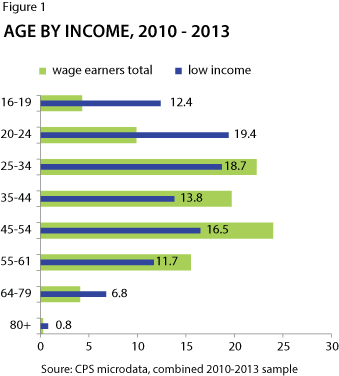
Higher levels of education improve wage outcomes for workers. More than 70 percent of low-income workers have less than a four-year college degree, but the largest share (37 percent) has some education beyond high school. However, among workers with less than a high school education, 73.1 percent earn less than $20,000. High school graduates and people with some college or an associate degree were about equally likely to have low incomes - 38.5 and 36.5 percent, respectively. Bachelor's degree holders and those with advanced degrees were much less likely to be working for low wages, at 20.1 percent and 12.6 percent, respectively (Figure 2).
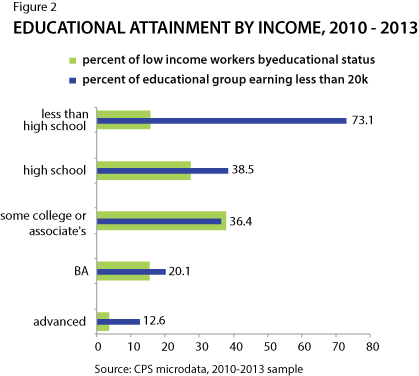
Some of the earnings outcomes for workers with lower educational statuses could be a result of labor force participants who haven't completed schooling - students working part time - but most (54.0 percent) of 16-24 year old low-income workers were not in school. However, students of any kind and high school students in particular are much more likely to be earning less than $20,000 annually. Because of their divided commitments and potential parental support, this is to be expected. In Figure 3 the black line represents the 46.2 percent of 16-24 year old wage earners who earn less than $20,000 per year.
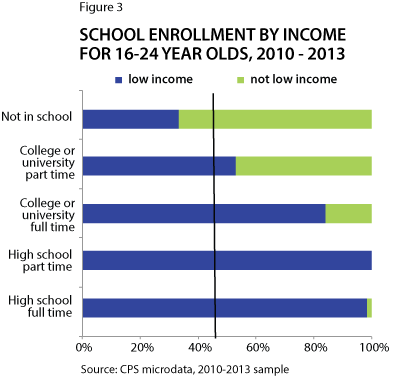
Overall, 21.8 percent of low-income workers are living in poverty based on their household status. The federal standard for a single individual is $11,670, well below our $20,000 threshold, so this mostly tells us the limitation of federal poverty status as a measure of wages.
Unsurprisingly, people with very low earnings work fewer hours than their higher income counterparts. However, nearly 60% of people earning $10,000-$19,999 annually worked more than 30 hours per week-- often at or near full-time hours (Figure 4).
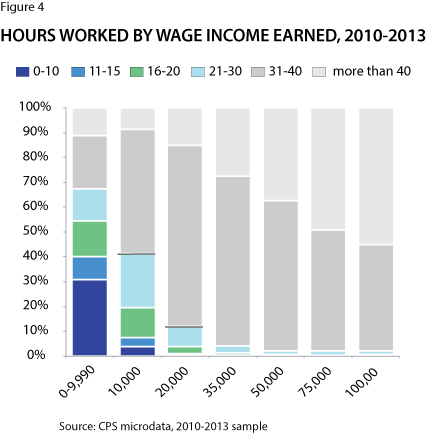
Most low-income workers worked part-time (less than 35 hours per week) at least some weeks of the past year - 60.3 percent. Of these, nearly half (48.5 percent) were working part time by choice, more than the 42.8 percent of all part-time workers. Low-income workers were also more likely to work part time because they were unable to find full-time work (13.4 percent) than all part-time workers (11.5 percent). They were less likely to say slack working conditions were why they worked part time, probably because low-skilled workers are easier to lay off and replace, while higher skilled and more highly paid workers are kept on during slack conditions (Figure 5).
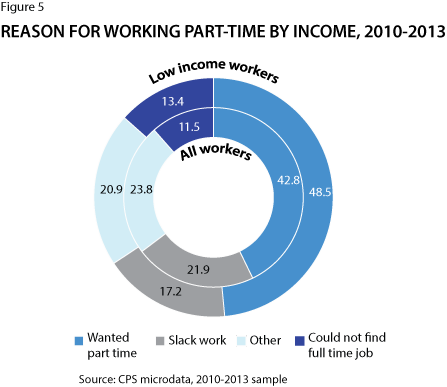
Another point to note is that these different variables within the same data set with the same respondents is giving us apparently competing views of the number of part-time low-income workers. Sixty percent work at least 30 hours per week, but 60 percent also worked fewer than 35. There are a few explanations for this: First, the second chart (reasons for working part time) is for the people who worked part time during any week of the previous year. They may normally work more hours and show up as full time in the first variable. Second, workers may be disproportionately kept in the 30-35 hours per week range because of policies on benefits. Third, low-income workers may be more likely to have variable schedules because of the nature of their work and the occupations they hold. Regardless, the inconsistency points to what may be a bigger problem for low-income workers - the unreliability of their incomes. It's much harder to budget and plan when the number of hours worked and dollars earned changes from week to week and month to month.
To add to their challenges from unreliable income and work, low-income workers are also least likely to have health insurance. They're much more likely to have public or government health insurance, probably because subsidies and federal programs are more available to low-income workers. Low-income workers are dramatically less likely to have employer health insurance. When we consider how far incomes go, health insurance can make a huge difference. Not only does the value of the insurance packages offered by employers exacerbate the gap between well-paid workers and low-income workers, but insurance's primary purpose is to make health costs predictable and manageable. Low-income workers, the people least likely to be able to build up a substantial emergency fund to cover unexpected health costs, are those most likely to incur them (Figure 6).
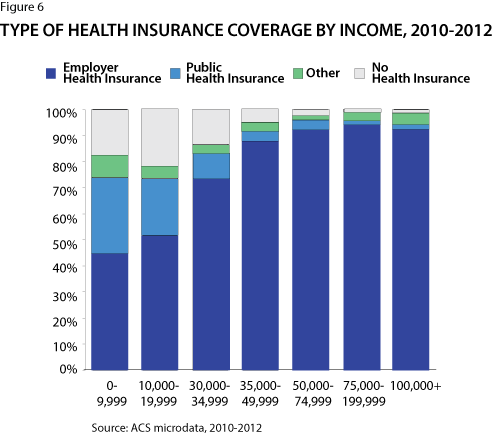
Income is also clearly related to transportation choices. The median commute time for low-income workers to travel to work is 15 minutes. The median for all workers to go to work is 20 minutes. If we examine mode of transportation to work, there are some clues why. Low-income workers are more likely to take bus, bicycle, walk, or work at home, while they're less likely to drive a car to work. This may be driven by three things. First, a worker who earns less than $20,000 may not be able to afford a car or may need to use other methods of transport to save on gas and maintenance costs. Second, a higher income can draw people to commute much further. Third, a higher income gives workers more choice in housing, and they may be choosing to live in nicer areas than can be found near their employers (Figure 7).
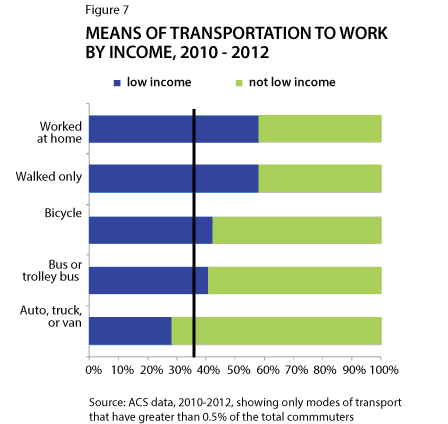
Low-wage jobs are also more dispersed - the highest paid workers in a company work in a corporate hub, but the lowest interact with people at retail and restaurant locations which are all over the place. As a result, low-income workers are likely more able to find jobs very near their homes.
Unsurprisingly, some occupations and industries are more commonly represented among low-income workers. Most are ones we'd all expect (Tables 1-2).
| Top 15 Minnesota Occupations Employing Low-Wage Workers, 2010-2013 (CPS) | ||
|---|---|---|
| Occupation | Percent of occupation's workers earning low wage | Percent of all low-wage workers working in the occupation |
| Cashiers | 82.4% | 5.2% |
| Retail salespersons | 57.2% | 3.8% |
| Cooks | 71.5% | 2.9% |
| Child care workers | 85.6% | 2.8% |
| Waiters and waitresses | 71.9% | 2.8% |
| Nursing, psychiatric, and home health aides | 58.1% | 2.7% |
| Janitors and building cleaners | 56.7% | 2.6% |
| Personal and home care aides | 69.3% | 2.5% |
| Farmers, ranchers, and other agricultural managers | 84.2% | 2.5% |
| Driver/sales workers and truck drivers | 31.7% | 2.1% |
| Teacher assistants | 71.6% | 2.1% |
| Maids and housekeeping cleaners | 74.5% | 1.8% |
| Stock clerks and order fillers | 55.0% | 1.6% |
| Laborers and freight, stock, and material movers, hand | 52.8% | 1.6% |
| Source: CPS microdata 2010-2013 sample | ||
| Top 15 Minnesota Industries Employing Low-Wage Workers, 2010-2013 (CPS) | ||
|---|---|---|
| Industry | Percent of industry's workers earning low wage | Percent of all low-wage workers working in the industry |
| Restaurants and other food services | 67.7% | 10.5% |
| Elementary and secondary schools | 34.1% | 6.1% |
| Construction | 26.4% | 4.4% |
| Grocery stores | 60.7% | 3.4% |
| Colleges and universities, including junior colleges | 37.4% | 3.0% |
| Animal production | 73.4% | 2.8% |
| Department stores and discount stores | 39.8% | 2.4% |
| Child day care services | 74.5% | 2.4% |
| Employment services | 63.1% | 2.1% |
| Crop production | 54.2% | 2.0% |
| Nursing care facilities | 39.7% | 1.9% |
| Home health care services | 58.6% | 1.9% |
| Other amusement, gambling, and recreation industries | 49.2% | 1.8% |
| Residential care facilities, without nursing | 58.0% | 1.5% |
| Individual and family services | 39.9% | 1.5% |
| Source: CPS microdata 2010-2013 sample | ||
The industries that have a large share of low-wage workers more closely correlate to the occupations that are disproportionately represented (note the highlighted rows in each table). There were a few surprises, though, like colleges and universities.
Although some of these industries and occupations are the temporary jobs of young people, many of them tend to employ adults attempting to support families. The low percentages of all low-wage workers employed in a given industry or occupation also suggests that low wages are fairly dispersed through different sectors of the economy - working for low wages is far more pervasive than we tend to assume.
The earnings picture for workers with the lowest wages is complex. Although some people work for low wages as a tradeoff for more time or to supplement other sources of family income, the majority of low-wage workers rely on every penny. As challenging as the wages are, the unreliability of work and the difficulties of planning ahead to get ahead are even worse.
In Minnesota we've recently created a Cost of Living calculation that attempts to gauge how much income a person needs depending on their specific family circumstances. You can find a selection of those options online
1Campolongo, Susan. BLS. "Multiple jobholding in states in 2013". August 2014.
2American Community Survey (ACS) 2008-2012 poverty status
3Federal poverty rates
4American Community Survey (ACS) 2008-2012 low-wage earners
5American Community Survey (ACS) 2008-2012
6Current Population Survey (CPS)